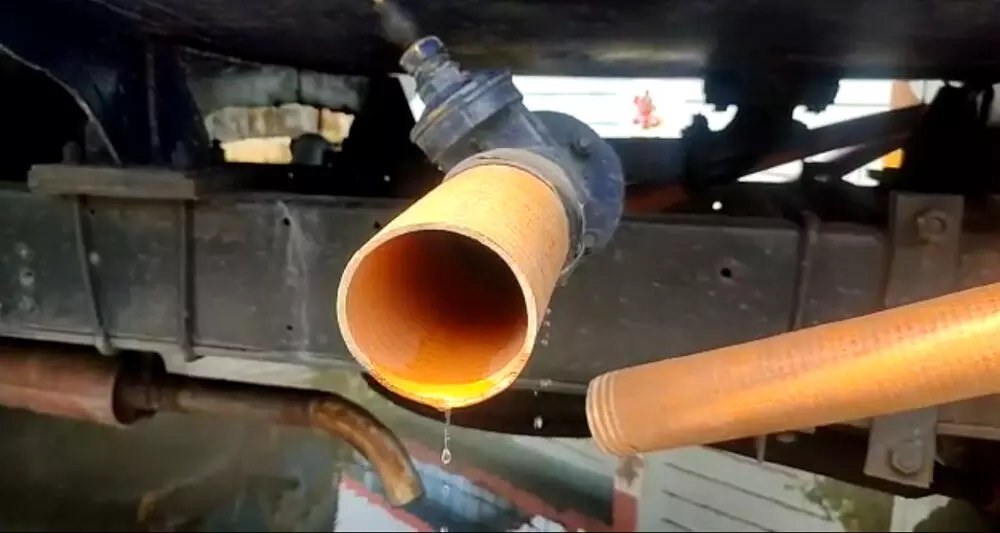
Guwahati, March 22: A total of 40 to 50 families from Sainiknagar in Noonmati area in Guwahati depend upon a Raijor Kua (public well) to meet their daily requirement of water.
"All the families cannot fetch water in a single day, so we have divided amongst ourselves on who will fetch water on a particular day. We are doing this to avoid any water crisis or clash among the families," says Nitul Sharma, a resident of Sainiknagar.
Moreover, people have to wait for an hour or two after every fetch for the water to emerge on the surface of the well before fetching water for themself.
Echoing on similar lines, Pramod Boro, also a resident of Sainiknagar said that apart from the well, the people sometimes depend upon a small stream located above the hills of the area. "We are left with no other option than purchasing water from private tankers. It usually costs Rs 200 for 700 litres of water but since we stay in a hilly area we are charged Rs 500," says Boro.
Boro further lamented that a few years back authorities from the concerned department laid down pipes for water supply project but the efforts are all in vain. "The pipes are installed in some areas and the rest of them are lying abandoned. The authorities came and surveyed the area but never showed up with some concrete solution. May be they will come next before elections," says a sarcastic Boro.
A resident from Hatigaon, Hasina Begum has a different story to share. "We do not have access to piped water supply and we are dependent on the well in our compound. There has been water depletion in the neighbourhood and so the people resorted to purchasing water. The private tankers are also taking advantage of the situation by charging high prices. Moreover, deep well boring has also resulted in the depletion of water level in the area. Earlier, during the monsoon, there used to be sufficient water in the well or tubewells but not anymore. The citizens and government both have to act responsibly to mitigate the crisis before its too late," says Hasina.
Recently, the Kamrup Metro district administration issued a blanket ban on the extraction of ground water without prior permission from the Central Ground Water Board on March 10 without even giving an alternate solution to the crisis-hit citizens. However, the ban was lifted after it landed in soup. The administration cited that due to public requests and for their convenience, the ban was lifted for domestic use.
Water Projects: Initiated but incomplete
As per reports, around 30% of households in the city have access to tap water, while others have to depend on private water suppliers or tubewells. To meet the crisis and supply potable water to the Guwahati Metropolitan Area, the Government of Assam had taken up four major water supply projects, with the funding from Government of India (JNNURM) for the South West region, Japan International Cooperation Agency (JICA) for the North and South Central regions and ADB for the South East region in the city a decade ago but those remained incomplete to date.
As per the website of the Assam Urban Infrastructure Investment Program, currently only 40% of the population has access to central piped water supply system. The key issues pertaining to the inadequate supply of water has been summarised as limited coverage of the system, dependence on non-potable water sources; non-uniform distribution both in terms of quality and quantity of water supplied; high levels of non revenue water (NRW), leakages in the distribution system; and low levels of cost recovery.
Notably, the present production from all sources (73.4 million per litres) is inadequate with respect to the present demand of around 150 million per litres.
The Assam Urban Infrastructure Investment Program notes that most of the treatment plants are also old and damaged due to which they are running much below their actual capacities. Various components are not functioning and as a result, both quantity and quality are not being assured.
The government initiated the Jal Jeevan Mission (JJM) under which every rural household is to be provided with Functional Household Tap Connection (FHTC) by 2024, however, people are concerned about how long this scheme will take as the previous projects remain incomplete.
Although the Department of Drinking Water and Sanitation (DDWS) in January claimed that Assam is well on track to achieve the target by 2024, Union Minister of Jal Shakti, Gajendra Singh Shekhawat recently expressed concern and pushed to expedite the speed and scale of implementation of the mission.
What needs to be done?
Despite the tall claims of development by the government including the present one has failed to mitigate the basic necessity of the citizens which is water. The much-hyped Smart City Guwahati, located on the banks of the mighty Brahmaputra which remains inundated during the monsoons, faces acute shortage when it comes to drinking water.
Researcher and Activist Arup Jyoti Das while speaking to The Assam Tribune said, "This mission (JJM) which aims to provide clean drinking water to rural areas is a very optimistic and promising one. Unfortunately, it is louder in words than in action. It is far away from what it had promised and has become a game of numbers rather than actual implementation in the context of Assam. There are a number of reports about the installation of water taps without water connectivity in many areas, besides regular complaints of corruption in the process. Without incorporating a strong monitoring and evaluation mechanism into the mission, it may emerge as another claim of success stories rather than a real success story."
